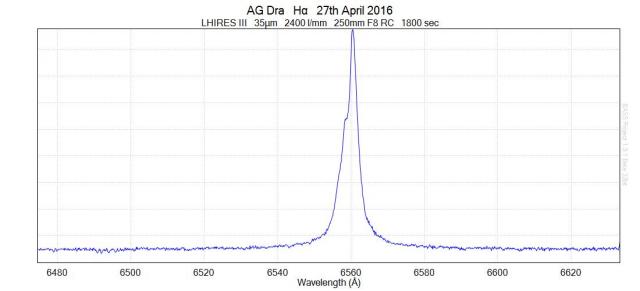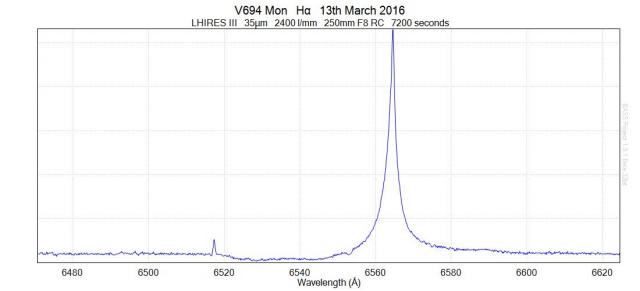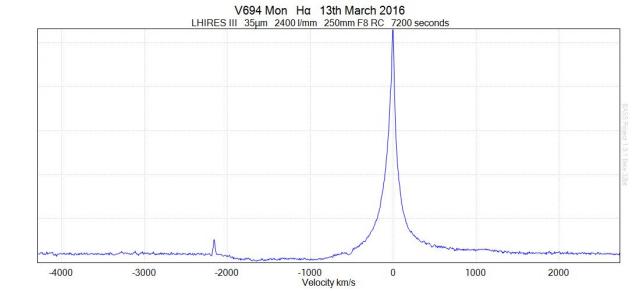Forum Replies Created
-
AuthorPosts
-
 Andy WilsonKeymaster
Andy WilsonKeymasterThanks for posting this Calum. Very interesting that spectroscopy is gradually getting more coverage.
I’m tempted to watch, but as there is a cost and it is more targetted at those starting out in spectroscopy I’ll probably give it a miss. Still very pleasing that S&T are showing an interest in spectroscopy.
Cheers,
Andy
 Andy WilsonKeymaster
Andy WilsonKeymasterGreat spectrum Alun! That is a good demostration of the effects of the instrument and atmosphere.
Andy
 Andy WilsonKeymaster
Andy WilsonKeymasterHi Wayne,
It was good to meet you before the meeting. I used to live in the South East and was a regular visitor to meetings and the pub afterwards. A really enjoyable way to meet new people and chat about astronomy. Unfortunately now I’m in the South West I had to leave before the end of the meeting to get home by midnight!
I hope to meet you for a longer chat at a future meeting.
Andy
 Andy WilsonKeymaster
Andy WilsonKeymasterHi Bill,
Great idea to try out a narrow band filter with a full aperture white light filter. Your results look pretty good.
Andy
 Andy WilsonKeymaster
Andy WilsonKeymasterA fascinating post David. It encourages me to take the next step and learn flux calibration.
Below is an H-alpha spectrum I obtained on 27th April. It is interesting to contrast that though I see detail in the profile, I miss even the nearby little blueward absorption line and redward emission line that you pick up. A good example of how low resolution and high resolution spectroscopy can complement each other.

Best wishes,
Andy
 Andy WilsonKeymaster
Andy WilsonKeymasterMy browser was playing up and I’ve removed a duplication of my previous comment.
 Andy WilsonKeymaster
Andy WilsonKeymasterHi Robin,
I expect that observing a very red star made a big difference in how faint I could go. I could not find any R magitude measurements but I’m sure it would have been brighter than 13th mag through an R filter.
There is also of course a difference between obtaining a high quality spectrum, and simply looking for a detection of whether or not H-alpha is in emission. My next challenge will be to learn to flux calibrate my spectra, so I can properly analyse the intensity changes for a future cycle of chi Cyg.
Best wishes,
Andy
 Andy WilsonKeymaster
Andy WilsonKeymasterHi Steve,
I think chi Cyg near minimum would make an excellent challenge for the Alpy, and it is only getting brighter. You would be able to see how the whole of the spectrum changes rather than just H-alpha.
A quick back of the envelope calculation. Your refractor has about a quarter of the light gather power of my RC. However, if I make the assumption that I can use resolution as an approximation to how dispersed the spectrum is across the chip (lots of assumptions..). My Lhires III has approximately 20 times the resolution of your Alpy, so you should get a spectrum that is about 20x brighter. So overall you might get 4-5x the intensity that I do. This is of course a very rough calculation, and it also assumes we get a similar throughput through the spectrograph slit, which is affected by a number of factors. I used my widest slit at 35 micrometers.
Thanks,
Andy
 Andy WilsonKeymaster
Andy WilsonKeymasterHi Bill,
They were actually not that long compared to some deep sky imagers. The 27th April spectrum was from a 1 hour exposure, made up of 6 x 10 minutes. For some targets I’ve gone out to 2 hours and I would have liked to have done that or more for chi Cyg but there is a limit to how late I can stay up until with work the next day.
I suspect chi Cyg is a little easier than some mag 13 stars, as that is a V filter magnitude. It is a very red star, and even more red at minumum, so there will be more light around H-alpha which is in the red part of the spectrum. Also, whenever there is an H-alpha emission line, then it is easier to get a good signal on a faint star, as a lot of light is concentrated in a narrow emission line.
Cheers,
Andy
 Andy WilsonKeymaster
Andy WilsonKeymasterThat’s a great investigation Bill. Fascinating to see the orbit of the meteor to go with the spectrum.
The instrument response correction cannot be easy over a wide field. At high resolution on a star, it is surprisingly straight forward once you’ve done it a few times as it is for a narrow part of the spectrum on a tiny field of view. (Though somehow I’ve managed to get a dodgy response curve tonight, but it is still clear so I can redo it.) It must be quite a challenge for meteor spectroscopy through a wide angle lens across a wide spectral range,
Cheers,
Andy
 Andy WilsonKeymaster
Andy WilsonKeymasterThat is brilliant news for Bill and Harold. Congratulations to Bill!
Andy
 Andy WilsonKeymaster
Andy WilsonKeymasterCongratulations Robin! You continue to do amazing work at very faint magnitudes for spectroscopy.
Andy
 Andy WilsonKeymaster
Andy WilsonKeymasterThat is a wonderful image James. It must have taken you a while to combine all of those sub exposures!
Andy
 Andy WilsonKeymaster
Andy WilsonKeymasterHi Tony,
I started out using a combination of MaximDL and BASS for my spectral processing. Though BASS could do it all I was used to Maxim and so it was easier to use that for dark frames and flat fields to begin with. I find BASS fairly easy to use and intuitive, at least for the basic stuff. Instrument response gets a bit more involved. BASS can be downloaded for free from the astrobodger Yahoo group (don’t be put off by the name!):
https://uk.groups.yahoo.com/neo/groups/astrobodger/info
Though I still use BASS for my final ‘displaying’ of spectra, I’ve switched to ISIS for all of my processing including dark frams and flat fields. Though it is a lot harder to use, once you’ve got to grips with it, then spectral processing is quick and easy. It automates much of the processing, and so is a lot quicker than the more manual processing in BASS. It is also used by many of the top amateurs which I consider a good indication that it does things right. It can be downloaded for free from Christian Buil’s website:
http://www.astrosurf.com/buil/isis/isis_en.htm
There are also some tutorials on the site. Though they are quite long I was able to get to grips with ISIS by going through the Lhires III tutorial in detail a couple of times.
I’ll just mention guiding as well, as this is very important for obtaining good spectra. I think there are several good packages out there. I use PHD2, which is free and has built in functionality that is good for spectroscopy. You can setup and adjust a spectrograph slit rectangular guide reticle. You can also nudge the guide location to move the target star exactly over the slit.
On the spectrograph front I think there is going to be something in the next BAA Journal, so I’d suggest holding back until this is published.
Best wishes,
Andy
 Andy WilsonKeymaster
Andy WilsonKeymasterThanks Steve.
Yes, that is a P Cygni profile in David and Hugh’s spectra, and as David points out it is also visible in my spectra, it is just very very spread out as it is at high resolution.
I obtained an even better spectrum on the 13th March. This has a slightly cleaner signal and you can start to see structure within the P Cygni absorption profile. For example the extra absorption around 6553 Angstroms. There is also an interesting emission peak at about 6517 Angstroms. I’m not sure what element this is from, but I would suspect it comes from has in the accretion disc. It even appears to show its own small P Cygni profile, though it is possible this is just noise. Note if this was a P Cygni profile then it would be from material travelling relatively slowly compared to the huge P Cygni at H Alpha.

I thought I’d show the same spectrum, but this time converted to velocity relative to the central H Alpha emission peak. This shows the absorption to the blue (shorter) wavelength goes beyond -2000 km/s. This is due to the hydrogen in the jet absorbing light, but it is blue shifted due to its fast velocity towards us.

Cheers,
Andy
 Andy WilsonKeymaster
Andy WilsonKeymasterHi Steve,
This is just an area of the BAA forum where members can post spectroscopy results, ask questions, or just make any general posts related to spectroscopy. This will make it easy to find interesting and useful spectroscopy forum posts in future.
Note this does not mean that all spectroscopy content has to be posted here, as there may be some topics that members wish to post to other relevant forum areas.
Cheers,
Andy
 Andy WilsonKeymaster
Andy WilsonKeymasterHi Bill,
Thanks for your feedback, which is useful to know. This does sound like it would be a worthwhile endeavour to create a database that covers as wide a range of objects as possible.
It is very interesting to see the improvement in resolution you have made over the years. The detail in your latest spectra are astounding when compared to the early ones.
Cheers,
Andy
 Andy WilsonKeymaster
Andy WilsonKeymasterHi Bill,
That is an excellent presentation of your results. You certainly had to do some detective work to find out where the lines came from, but I find that is part of the fun.
I’m not sure if you have any opinion on my post about the possibility of creating a BAA database of spectroscopic observations? Would you be interested in submitting meteor spectra to such a database? I should also run it by John Mason, and other section directors.
Best wishes,
Andy
 Andy WilsonKeymaster
Andy WilsonKeymasterHi James,
Along the lines of what Grant says, good flat fields would be very important for this to work. Otherwise the shifting position of the stars would introduce variability due to vignetting, dust motes, and any other variation in sensitivity across the image.
Assuming you’ve got good flats then I think you would get good results. You can check how well it is working by including a non-variable check star in your processing, to check that it stays roughly constant rather than varying.
Andy
 Andy WilsonKeymaster
Andy WilsonKeymasterRobin, that is exactly what I was thinking. The data in the FITS header would be read by the database, so potentially any of it could be used for searches to compile lists of spectra that could be viewed or downloaded.
The users would only have to enter data the once, in the fits header, and things like lat/long just once in their processing software. The data would probably be extracted and stored as fields within the database, an automated process. Ideally this would not be needed but to make the website responsive and quick this would almost certainly need to happen, though this would be invisible to users.
I’ve taken a quick look at FITS file formats and I need to spend some more time on it. The header is very straight forward, while the actual spectrum data more complex. There are options to build software to read the data from scratch or to use programs that already exist to do this instead. It would be very useful to make contact with the VdS spectroscopy group, so an introduction to any contacts would be most welcome. Knowing what has already been done and how could make the whole process of setting up a database and associated website much easier.
Thanks, Andy
-
AuthorPosts
